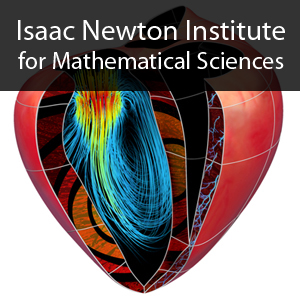Termination of atrial fibrillation using pulsed low-energy far-field stimulation; a computational and optical mapping study
Duration: 18 mins 54 secs
Share this media item:
Embed this media item:
Embed this media item:
About this item

| Description: |
Fenton, F (Cornell)
Wednesday 22 July 2009, 10:30-10:45 |
|---|
| Created: | 2009-07-24 18:13 | ||
|---|---|---|---|
| Collection: | Cardiac Physiome Project | ||
| Publisher: | Isaac Newton Institute | ||
| Copyright: | Fenton, F (Cornell) | ||
| Language: | eng (English) | ||
| Distribution: |
World
|
||
| Credits: |
|
||
| Explicit content: | No | ||
| Aspect Ratio: | 4:3 | ||
| Screencast: | No | ||
| Bumper: | UCS Default | ||
| Trailer: | UCS Default | ||
| Abstract: | Electrical therapies for termination of atrial fibrillation fall into two categories, anti-tachycardia pacing (ATP), which is effective in terminating only slow tachycardias, and cardioversion, which uses high-energy shocks that can produce tissue damage and patient pain. We propose a new method that is effective for slow and fast tachycardia and fibrillation and requires very low energies. We demonstrate theoretically and experimentally that low-intensity field stimulation can create wave emission (“virtual” electrodes that can act as control sites) from tissue bordering natural anatomical heterogeneities within cardiac tissue and that the number of these activation sites depends on the sizes of the heterogeneities and the electric field strength applied. Using high-resolution magnetic resonance imaging (MRI) of canine cardiac structure and computer simulations of the bidomain model with canine ionic models, we quantify the recruitment of activation sites from heterogeneites as a function of low applied electric field strengths and their ability to terminate reentrant arrhythmias. Then, using optical mapping in isolated perfused canine cardiac preparations, we show that a series of pulses at low field strength (0.9-1.4 V/cm) recruits a sufficient number of activation sites to entrain and subsequently extinguish AF with a success rate of 93 percent (69/74 trials in 8 preparations). Thus, AF can be terminated by FF-AFP using on average only 13% of the energy required for cardioversion. This marked reduction in energy can be expected to increase the effectiveness and safety of terminating atrial tachyarrhythmias clinically. |
|---|---|
Available Formats
| Format | Quality | Bitrate | Size | |||
|---|---|---|---|---|---|---|
| MPEG-4 Video | 480x360 | 1.83 Mbits/sec | 259.60 MB | View | Download | |
| WebM | 450x360 | 572.35 kbits/sec | 78.60 MB | View | Download | |
| Flash Video | 480x360 | 797.3 kbits/sec | 109.98 MB | View | Download | |
| iPod Video | 320x240 | 504.57 kbits/sec | 69.60 MB | View | Download | |
| QuickTime | 480x360 | 506.78 kbits/sec | 69.91 MB | View | Download | |
| MP3 | 44100 Hz | 125.0 kbits/sec | 17.04 MB | Listen | Download | |
| Windows Media Video | 477.36 kbits/sec | 65.85 MB | View | Download | ||
| Auto * | (Allows browser to choose a format it supports) | |||||

